|
Of course the allusion in this
title, "'The Better to See With...' Plexiglas Machine Gun Turrets" is to "Little
Red Riding Hood." Do you remember the scene in "It's a Wonderful Life" where
Sam Wainright's
new factory has a busy production line turning our Plexiglas canopies? "I
have a big deal coming up that's going to make us all rich. George, you remember
that night in Martini's bar when you told me you read someplace about
making
plastics out of soybeans?" George passed it up and Sam got rich. Plastics
were rarely found in products prior to World War II. A shortage of metal, glass,
and rubber (recall the surplus materials collections) gave birth to a thriving
plastics industry that included aircraft canopies. Prior to that, you will note
the flat glass window panes used in windshields and canopies built in segments
using metal frames. The one photo of the line worker applying a coat of Simoniz
to the Plexiglas canopy reminds me of the company's slogan
"Motorists wise, Simoniz,"
which was made famous again in the original story version of "A Christmas
Story," by Gene Shepherd, entitled "Duel
in the Snow, or Red Ryder Nails the Cleveland Street Kid."
"The Better to See With..." Plexiglas Machine Gun Turrets
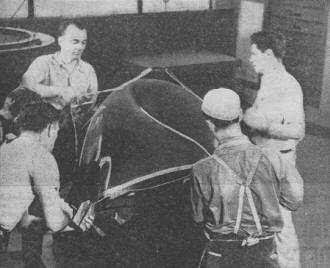
Edges of the sheet are clamped to form before the material
cools. At 200 degrees, Plexiglas may be handled by workers wearing ordinary
cotton gloves.
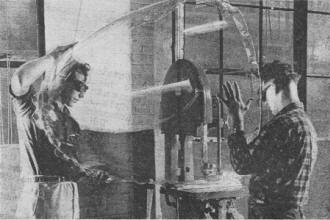
Workmen cut to shape a rough form of the plastic. This turret covering is the
Nose of a Martin B-26. Material is said to be more transparent than glass.
With the advent of streamlining and covered machine gun turrets, a good plastic
was needed. Of all that have been tried to date, Plexiglas is rated as being the
best.
by Ralph Tekel
At the Great Air Corps training center of Randolph Field, Army flying instructors,
used to give fledglings the following advice: "Try to make a ball and socket joint
of your neck. Keep your head and eyes moving, watching the whole sphere. Remember
you're not driving down a highway where traffic is on one level; in the air another
ship can come at you from any direction, so if you expect to become good military
pilots you must try to look in all directions at once."
Good advice, no doubt - but also a pain in the neck!
That advice was given in all sincerity, and the reason is obvious. Surprise is
the basic advantage in aerial warfare. The unexpected attack has a greater chance
of success than the anticipated one for there is neither time nor opportunity for
the enemy to counter-attack.
In the design of a modern bomber, fighter, or anything that has wings and machine
guns, great emphasis is placed on the best possible visibility for the pilot, gunners,
and bombardiers. Not so, long ago such emphasis carried out on this characteristic
necessarily meant sacrifices for other qualities. But the latest method's assuring
unlimited visibility have come a long way since the old celluloid windshield and
helmet and goggle days.
The quickening pace of military aviation development imposed upon the engineers
and designers the responsibility of protecting the crews and at the same time providing
them with unobstructed views from all conceivable angles. Logically, the use of
transparent plastic sheets, which have paralleled aircraft development so closely
in the last six years, provides the solution of the designers' problem.
The acrylic. plastic sheets developed from synthetic resins are outstanding in
colorless transparency, chemical resistance, and stability against weathering and
aging. The manufacturers call these sheets Plexiglas.
Plexiglas is actually more transparent than glass and retains this feature in
spite of glaring sunlight, and extremes of temperature and humidity encountered
by the aircraft. It is less than half the weight of glass, and is yet able to withstand
greater impact.
As a plastic, Plexiglas can be formed to the two or three dimensional sections
required for streamlining nose turrets, cockpit enclosures, blisters, and power-driven
turrets. It is also easy to cut and drill and can therefore be mounted in lightweight
extruded aluminum channels to eliminate the necessity of braces and supports that
so seriously hamper perfect visibility.
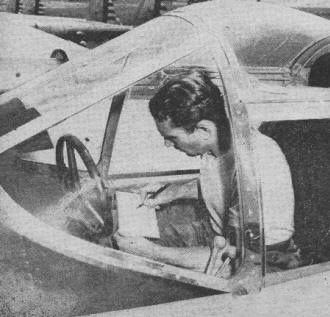
Note the smooth streamlining achieved on the Lockheed P-38
Lightning's cockpit enclosure.
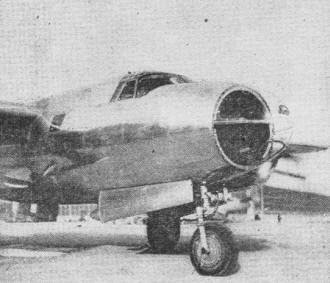
A close-up of the nose installed on the Martin B-26 which
embodies latest combat features.
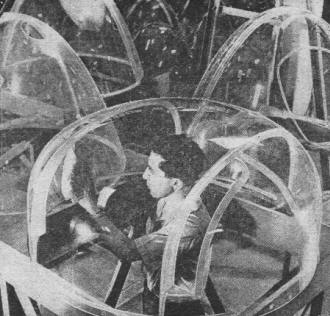
Impervious to the action of gasoline, acids, and oil, Plexiglas is polished
with Simoniz.
Plexiglas is known technically as methyl methacrylate resin. The basic substances
used in its manufacture are made from coal, petroleum, air, and water. When bituminous
coal is used, it is heated in a coke oven and the byproducts are collected. Among
these is a gas called propylene which, by a series of chemical reactions, is transformed
into the well-known constituent of airplane dope, acetone. A further conversion
of acetone produces a basic material called unpolymerized methyl methacrylate. This
can also be made from byproducts of petroleum. From here the basic material is polymerized
at the ideal temperature, which was found to be 60 degrees centigrade.
Polymerization is merely the attaching of one molecule of methyl methacrylate
to another and still another in a chain until they intertwine and form a solid called
methyl methacrylate polymer - which is the technical term for Plexiglas. The resultant
Plexiglas is a hard, bubble free, transparent plastic impervious to air, rain, and
acids. Gasoline, oils, fats, waxes, and destructive bacteria, moreover, do not effect
this material.
Considerable care is exercised in the making of a Plexiglas aircraft part. The
manufacturer starts with a flat cast sheet which is protected from dirt and other
foreign matter so that there will be nothing in or on the sheets to distort the
vision of the pilot or gun crews.
The cast sheet is suspended in a hot air oven until it reaches the best forming
temperature of 220-250 degrees Fahrenheit. After being heated, the Plexiglas is
pliable and cool enough to be handled by workmen wearing cotton gloves.
The molding form is generally made of either wood, metal, or plaster or a combination
of these three materials. The surface is carefully sanded and covered with outing
flannel or billiard felt to eliminate rough surfaces. Before the mold is made, however,
the airplane manufacturer designs the installation and usually submits preliminary
prints for study of the Plexiglas engineering and productions staffs.
For three-dimensional curves, the material is stretched across the form or, for
some sections, pressed between male and female molds. When cool, the formed she
e t is lifted off the mold and is trimmed to specifications. The adaptability of
Plexiglas allows it to be cut, carved, etched, engraved, turned and ground, polished
and even "welded" without leaving a seam. Fine tooth saws are used in trimming,
since they leave the piece. with relatively smooth edges.
The next step is machine and buffing operations. Holes are drilled to facilitate
insertion of bolts which hold the shaped form in aluminum channels. Inasmuch as
the surface of Plexiglas is softer than glass it is easily marred unless the proper
precautions are taken. In cleaning, no ordinary kitchen scouring compounds are used;
instead, Simoniz cleaner and polish satisfactorily removes minor scratches. Army,
Navy, and most commercial airplane maintenance staffs are equipped with portable
buffing machines which can remove the more serious damages that are likely to occur.
Polishing and buffing does not influence the life of Plexiglas and many panels have
already put in four or five years of hard service without appreciable loss of light
transmissions or general visibility.
Mounting Plexiglas sheets requires utmost care. Since it is resilient, undue
stress brought on in bolting and riveting operations are avoided to prevent high
pressures directly on the plastic itself. The use of shoulder rivets or a metal
tube spacer a few thousandths of an inch larger than the thickness of the glass
sheet protects the plastic from direct pressure. Most popular backing is rubberized
fabric, which is plastic enough to compensate for thickness variations in the sheet
or width variations in the mounting channels. Because Plexiglas is subject to thermal
expansion and contraction, as well as internal pressure because of airflow over
its surface, the rubberized material serves the purpose best and also makes the
edges watertight.
One of the advantages of Plexiglas sheet is that its edges can be routed and
beveled to set flush with the outside of the airplane's metal surface so that there
will be no protruding edges or corners to set up drag at high speeds. The availability
of sheets in sizes up to 45" by 60" gives the aircraft engineer the widest latitude
in designing transparent sections. For many purposes, 0.250" or thinner material
has proven satisfactory. On low speed ships and gliders, sheet as thin as 0.060"
to 0.100" may be used. Sections in high-speed planes are usually 0.125" to 0.150"
in thickness when they are less in area than one square foot. The material used
for landing light covers is usually thicker glass to allow for a routed edge.
Plexiglas has a specific weight of 1.1 against the 2.6 of ordinary glass - meaning
that the use of four square yards of Plexiglas for airplane windows brings a savings
of about 50 pounds of weight against that of plain glass of the same thickness.
Tests with Plexiglas of 1/8" thickness and plain glass of 1/4" thickness showed
that the former could withstand the onslaught of 8 to 10 times the number of blows.
When Plexiglas cracks it doesn't splinter like ordinary glass but breaks up into
large, dull-edged pieces. It is not bullet-proof; tests, however, have shown that
bullets penetrating Plexiglas usually leave a clean, round hole rather than shattering
a whole section. Its reaction to rapid fire of machine guns is just about the same
as that of bullets hitting the aluminum alloy covered sections of a fighting plane.
A further development for Plexiglas in the aviation field has been the use of
this material for housing radio and range finder antennae. Far from reducing reception
efficiency, Plexiglas housings cut down static as well as other interference to
an appreciable extent. Further, it is better in hail and sleet resisting than metal
housings.
Plexiglas' light weight, high impact strength, durability, and permanent transparency
plays an important part in our national defense scheme. Sheets of this same acrylic
plastic forms the windows, landing light covers, commander's domes, and machine
gun blisters on every type of military plane now being made. It is also rapidly
finding favor on commercial ships.
The manufacturer of Plexiglas is the Rohm & Hass Company, of Philadelphia,
whose shops are kept busy turning out the enclosures for today's and tomorrow's
high-speed, high-altitude military planes.
Posted August 26, 2023
|